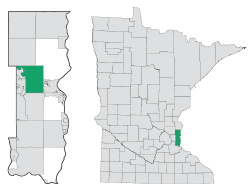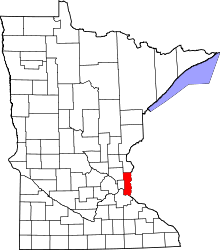Grant, Minnesota
| Grant, Minnesota | |
|---|---|
| City | |
 Location of the city of Grant within Washington County, Minnesota | |
| Coordinates: 45°4′54″N 92°55′16″W / 45.08167°N 92.92111°WCoordinates: 45°4′54″N 92°55′16″W / 45.08167°N 92.92111°W | |
| Country | United States |
| State | Minnesota |
| County | Washington |
| Area[1] | |
| • Total | 26.52 sq mi (68.69 km2) |
| • Land | 25.10 sq mi (65.01 km2) |
| • Water | 1.42 sq mi (3.68 km2) |
| Elevation | 1,010 ft (308 m) |
| Population (2010)[2] | |
| • Total | 4,096 |
| • Estimate (2012[3]) | 4,126 |
| • Density | 163.2/sq mi (63.0/km2) |
| Time zone | Central (CST) (UTC-6) |
| • Summer (DST) | CDT (UTC-5) |
| ZIP code | 55082, 55115 |
| Area code(s) | 651 |
| FIPS code | 27-25334[4] |
| GNIS feature ID | 1777317[5] |
| Website | www.cityofgrant.com |
Grant is a city in Washington County, Minnesota, United States and a suburb of St. Paul. The population was 4,096 at the 2010 census.[6]
History
The city was named for Maj. Gen. Ulysses S. Grant.[7]
Geography
According to the United States Census Bureau, the city has a total area of 26.52 square miles (68.69 km2); 25.10 square miles (65.01 km2) is land and 1.42 square miles (3.68 km2) is water.[1] Minnesota State Highways 36 and 96 are two of the main routes in the community.
Demographics
| Historical population | |||
|---|---|---|---|
| Census | Pop. | %± | |
| 2000 | 4,026 | — | |
| 2010 | 4,096 | 1.7% | |
| Est. 2015 | 4,147 | [8] | 1.2% |
2010 census
As of the census[2] of 2010, there were 4,096 people, 1,464 households, and 1,235 families residing in the city. The population density was 163.2 inhabitants per square mile (63.0/km2). There were 1,509 housing units at an average density of 60.1 per square mile (23.2/km2). The racial makeup of the city was 96.7% White, 0.2% African American, 0.3% Native American, 1.8% Asian, 0.3% from other races, and 0.6% from two or more races. Hispanic or Latino of any race were 1.8% of the population.
There were 1,464 households of which 33.3% had children under the age of 18 living with them, 76.8% were married couples living together, 4.8% had a female householder with no husband present, 2.7% had a male householder with no wife present, and 15.6% were non-families. 12.8% of all households were made up of individuals and 5.1% had someone living alone who was 65 years of age or older. The average household size was 2.79 and the average family size was 3.05.
The median age in the city was 47.7 years. 23.7% of residents were under the age of 18; 6.5% were between the ages of 18 and 24; 14.4% were from 25 to 44; 40.6% were from 45 to 64; and 14.8% were 65 years of age or older. The gender makeup of the city was 50.8% male and 49.2% female.
2000 census
As of the census[4] of 2000, there were 4,026 people, 1,374 households, and 1,215 families residing there. The population density was 156.8 people per square mile (60.5/km²). There were 1,399 housing units at an average density of 54.5 per square mile (21.0/km²). The racial makeup of the city was 98.14% White, 0.15% African American, 0.07% Native American, 0.89% Asian, 0.45% from other races, and 0.30% from two or more races. Hispanic or Latino of any race were 1.19% of the population.
There were 1,374 households out of which 39.9% had children under the age of 18 living with them, 82.6% were married couples living together, 3.6% had a female householder with no husband present, and 11.5% were non-families. 9.1% of all households were made up of individuals and 3.0% had someone living alone who was 65 years of age or older. The average household size was 2.93 and the average family size was 3.11.
In the city the population was spread out with 28.1% under the age of 18, 5.3% from 18 to 24, 24.3% from 25 to 44, 34.2% from 45 to 64, and 8.1% who were 65 years of age or older. The median age was 42 years. For every 100 females there were 104.9 males. For every 100 females age 18 and over, there were 100.6 males.
The median income for a household in the city was $98,228, and the median income for a family was $104,601. Males had a median income of $65,441 versus $38,895 for females. The per capita income for the city was $44,486. About 1.7% of families and 1.8% of the population were below the poverty line, including 1.3% of those under age 18 and 9.5% of those age 65 or over.
See also
References
- 1 2 "US Gazetteer files 2010". United States Census Bureau. Retrieved 2012-11-13.
- 1 2 "American FactFinder". United States Census Bureau. Retrieved 2012-11-13.
- ↑ "Population Estimates". United States Census Bureau. Retrieved 2013-05-28.
- 1 2 "American FactFinder". United States Census Bureau. Retrieved 2008-01-31.
- ↑ "US Board on Geographic Names". United States Geological Survey. 2007-10-25. Retrieved 2008-01-31.
- ↑ "2010 Census Redistricting Data (Public Law 94-171) Summary File". American FactFinder. U.S. Census Bureau, 2010 Census. Retrieved 23 April 2011.
- ↑ Upham, Warren (1920). Minnesota Geographic Names: Their Origin and Historic Significance. Minnesota Historical Society. p. 569.
- ↑ "Annual Estimates of the Resident Population for Incorporated Places: April 1, 2010 to July 1, 2015". Retrieved July 2, 2016.
- ↑ "Census of Population and Housing". Census.gov. Retrieved June 4, 2015.
